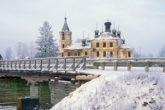Valdai: Pure nature and spirituality
Photos by William Brumfield
Today, the road from Moscow to St. Petersburg is today an obstacle course but the road between Russia’s two capitals has occupied a distinctive place in Russia’s culture and history. During the medieval period, it led through Tver to Novgorod.
And with the founding of St. Petersburg in 1703, the road became Russia’s central artery, traversed by potentates and peasants alike. As many observers noted, this road reflected the strengths and contradictions of the entire country.
How to get there
To get to Valdai take one of regular trains from Moscow or St. Petersburg following to Pskov and get off at Valdai station.
Among the notable towns along the way, Valdai can claim a special place, not because of its wealth or size but because of the natural beauty of its setting.
The town is spread on gentle hills that slope toward the southwestern shore of picturesque Lake Valdai, from which the region takes its name.
Valdai has traditionally been connected with the ancient commercial and religious center of Novgorod and remains a part of Novgorod Region. A settlement called Valdai first appeared in the historical record at the end of the 15th century.
A major advance in the village's fortunes occurred in the early 1650s, when the recently appointed head of the Russian Church, Patriarch Nikon (1605-81), informed Tsar Alexei Mikhailovich of his wish to found a monastery on an island in Lake Valdai.
Nikon became aware of the beauty of the region while serving as the metropolitan of the Novgorod Diocese from 1649-1652. With the tsar’s approval and financial support, work began on the monastery in 1653.
Nikon dedicated the new monastery to the Iverskaya Icon of the Mother of God, one of the most revered of wonder-working Orthodox icons, thought by devout believers to have been painted by the Apostle Luke and kept at the Iviron Monastery within the complex of monasteries on Mount Athos in Greece.
A copy of the icon was commissioned by Nikon and brought to Moscow in 1648.
The development of the monastery accelerated in 1655 with the transfer of a large group of monks from the Epiphany-Kuteinskii Monastery, located in the town of Orsha in the Vitebsk region of what is today Belarus. With them they brought a printing press, as well as a knowledge of the Western church culture visible in the Catholic monasteries of the Vitebsk area.
The Belarussians also included highly experienced potters, who refined a polychrome faience technique at the ceramic workshop that Nikon established for the Valdai monastery.
Their work greatly influenced the development of rich ceramic decoration of Russian church architecture in the late 17th century, particularly at another major project sponsored by Nikon, the cathedral at the Resurrection New Jerusalem Monastery on the Istra River near Moscow.
In 1653, construction began on the Valdai monastery’s major church, the brick Cathedral of the Iverskaya Mother of God, designed by the master builder Averky Mokeev, with certain features echoing the Church of the Holy Sepulcher in Jerusalem.
The cathedral was consecrated in 1656. With the dedication of his monastery, as well as with the form of its central church, Nikon had commemorated two of the most sacred sites of Orthodox Christianity, Jerusalem and Mount Athos.
The second major structure at the monastery was the Cathedral of the Epiphany, built by Mokeev in 1657-58 with a large attached refectory hall for communal meals.
In the mid-18th century this structure was heightened with a second level and altar dedicated to the Descent of the Holy Spirit.
Other churches at the monastery include the Church of Yakov of Borovichi, built in 1702 for the relics of a 16th-century Novgorod ascetic and “Fool in Christ” whose memory was venerated by Nikon.
Over the main gate of the outer west wall is the Church of Metropolitan Philipp of Moscow (1674), martyred during the reign of Ivan IV (the Terrible). The monastery has a second, inner gateway that opens onto the cathedral court. Over this gate is the imposing Church of the Archangel Michael (1685).
A substantial building campaign in the 1680s added brick cloisters as well as a tall bell tower attached to the abbot’s residence. Nikon, however, did not see the monastery’s flourishing. His imperious personality brought him into conflict with the tsar in 1666 and he was exiled to the north.
The mid 18th century saw further expansion of the monastery, including its brick walls and towers.
After the Russian Revolution, the monastery existed for a few years as an agricultural commune, but it was finally closed in 1927 with the loss of its most sacred icon. The buildings were used for various purposes, including as a museum.
During the late Soviet period, its attractive setting made it a tourist base, but lack of maintenance led to a steady decline.
Returned to the Orthodox Church in 1991, the monastery has undergone a prolonged restoration intended to serve as an examplar of Russian monastic life--just as Nikon had originally intended.
The main monastery church, long known as the Dormition Cathedral, was refurbished on the exterior and interior, including its frescoes. For the first time in its history, the capacious copper cupolas were surfaced with gold leaf.
In 2008 Patriarch Alexei rededicated the cathedral to the Iverskaya Icon. Located on Selvitsky Island, the monastery is now easily accessible over an attractive tree-lined causeway.
Although somewhat dilapidated in appearance, the town of Valdai has its charms, including leafy boulevards flanked by 19th-century houses and shops. Valdai also has gems of neoclassical architecture.
The best of these is the Church of St. Catherine (late 18th century), designed in the form of a classical rotunda and attributed to Nikolai Lvov, one of Russia’s most accomplished neoclassical architects. It is now a museum of bells - once Valdai's most famous export.
All rights reserved by Rossiyskaya Gazeta.
Subscribe
to our newsletter!
Get the week's best stories straight to your inbox
